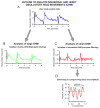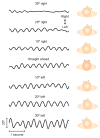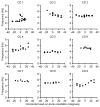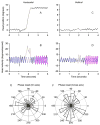Oscillatory head movements in cervical dystonia: Dystonia, tremor, or both?
- PMID: 25879911
- PMCID: PMC4868362
- DOI: 10.1002/mds.26231
Oscillatory head movements in cervical dystonia: Dystonia, tremor, or both?
Abstract
Cervical dystonia is characterized by abnormal posturing of the head, often combined with tremor-like oscillatory head movements. The nature and source of these oscillatory head movements is controversial, so they were quantified to delineate their characteristics and develop a hypothetical model for their genesis. A magnetic search coil system was used to measure head movements in 14 subjects with cervical dystonia. Two distinct types of oscillatory head movements were detected for most subjects, even when they were not clinically evident. One type had a relatively large amplitude and jerky irregular pattern, and the other had smaller amplitude with a more regular and sinusoidal pattern. The kinematic properties of these two types of oscillatory head movements were distinct, although both were often combined in the same subject. Both had features suggestive of a defect in a central neural integrator. The combination of different types of oscillatory head movements in cervical dystonia helps to clarify some of the current debates regarding whether they should be considered as manifestations of dystonia or tremor and provides novel insights into their potential pathogenesis.
Keywords: basal ganglia; cerebellum; midbrain; neural integrator; torticollis.
© 2015 International Parkinson and Movement Disorder Society.
Conflict of interest statement
Figures





References
-
- Chan J, Brin MF, Fahn S. Idiopathic cervical dystonia: clinical characteristics. Mov Disord. 1991;6:119–126. - PubMed
-
- Pal PK, Samii A, Schulzer M, Mak E, Tsui JK. Head tremor in cervical dystonia. Can J Neurol Sci. 2000;27:137–142. - PubMed
-
- Valls-Sole J, Tolosa ES, Nobbe F, et al. Neurophysiological investigations in patients with head tremor. Mov Disord. 1997;12:576–584. - PubMed
-
- Jankovic J, Leder S, Warner D, Schwartz K. Cervical dystonia: clinical findings and associated movement disorders. Neurology. 1991;41:1088–1091. - PubMed
Publication types
MeSH terms
Grants and funding
LinkOut - more resources
Full Text Sources
Other Literature Sources
Medical

